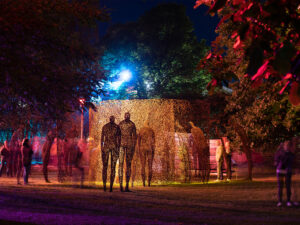Elga Wimmer

After the hassle and buzzle of the preview days of the Venice Biennial 2024 and long queues
to enter Pavilions, Palazzos with Collateral exhibitions, and exhibition spaces all around Venice,
the Mongolian Pavilion felt like an oasis of Zen serenity, enveloped by the sound of chimes, recalling the atmosphere of a Buddhist temple.
Artist Ochirbold Ayurzuna was born in 1975 in Tumentsogt, Mongolia, into a nomadic family of artisans, whose tradition of craftsmanship in artistry – as sacred figurine and golden stupa -and ancient musical instruments – as the Mongolian horse-man fiddle reminiscent of the God Maidar’s mule – greatly influenced Ochirbold as a child. As a young adult he won a scholarship at the School of Fine Arts in the Mongolian capital of Ulaanbaatar, and graduated in 1998. Ochirbold Ayurzana still resides in the capital of Mongolia and exhibits frequently in Europe. His sculptures can be seen at the United Nations in New York.
Entering the first room of the Mongolian Pavilion suspended aluminum skeletons with skulls featuring two, at times a third eye, were slightly dancing in the air. The symbolism for a three-eyed skull is deity, for a two-eyed one humans, and for a one-eyed one hell. I was told by curator Oyunjargal Oyuntuya, Cultural Envoy of Mongolia, the skeleton, named Citipati, represents the male Gods of the present in the first room, while the suspended skeletons in the second room represent the female Gods, Citipati of the future. The story of Citipati talks of former thieves and liars on earth, who left everything behind – even flesh and muscles – to enter heaven, and now protect people from corruption and thieves. They are friendly Gods – often used as talisman- and even as otherwise ghostly skeletons, exuding a joyous and spiritual presence, meant to augment consciousness. Citipati were the inspiration for Ochirbold’s exhibition at La Biennale de Venezia, a revered talisman deity associated with overcoming death, loss, accidents, and theft.
The central ‘altar piece’ to this installation is a Thangka – in ancient meaning a recorded message – of a Mongolian Buddhist painting. Thangkas were teaching and meditation tools by religious scholars. More than 80 % of the population in Mongolia is Buddhist. The name of the head of the Buddhist monks, Dalai Lama, derives from the Mongolian word Dalai, which represents the sea, the all-encompassing endless, the concept of heightened consciousness.
A cyclical process of heightened consciousness is by revisiting the past to progress towards the future, emphasizing the reciprocity of time and human aspiration. Interpretations can range from enlightenment to political commentary, addressing a global theme that appeals to greater humanity. The artist thrives to express a desire to encapsulate and explore the essence of a mindful living that binds humans and nature alike.
Perhaps it is the fact that Ochirbold Ayurzana still resides in Mongolia that inspires him to create such spiritual and somewhat healing concepts in his wonderful sculptural work – it certainly was this effect that I carried away with me.

